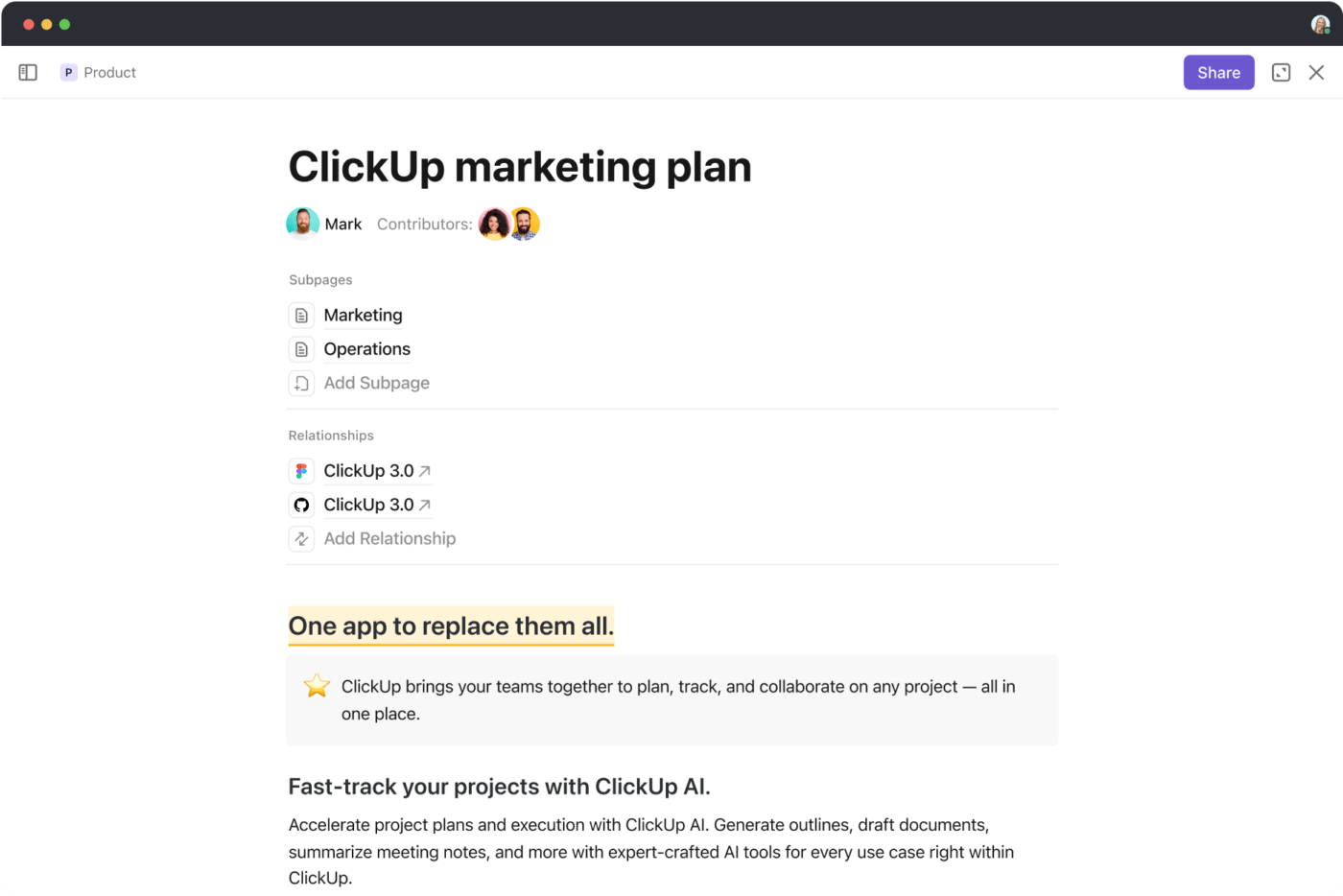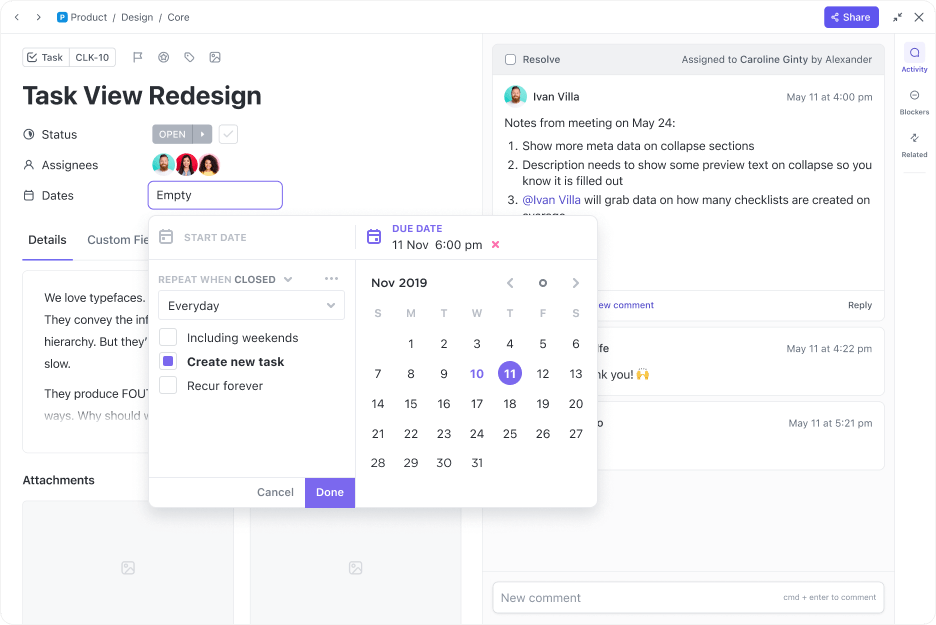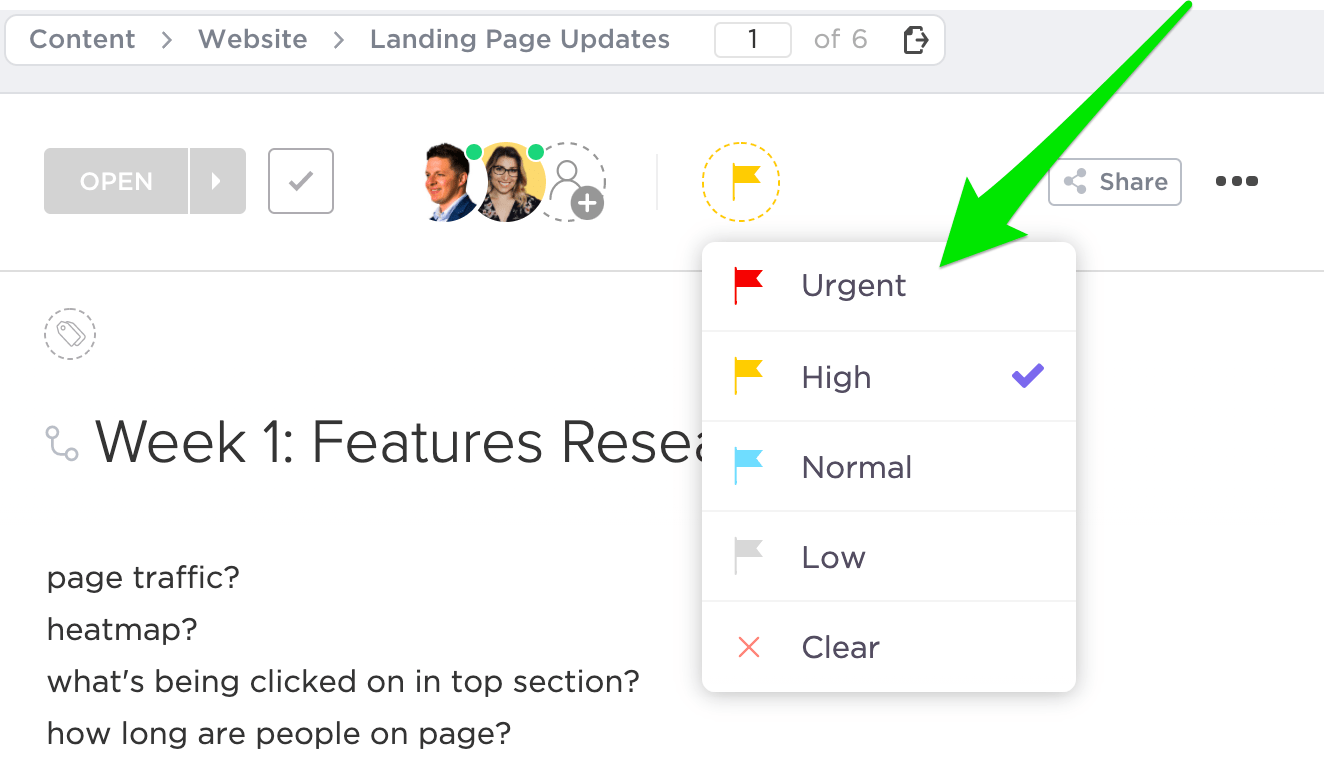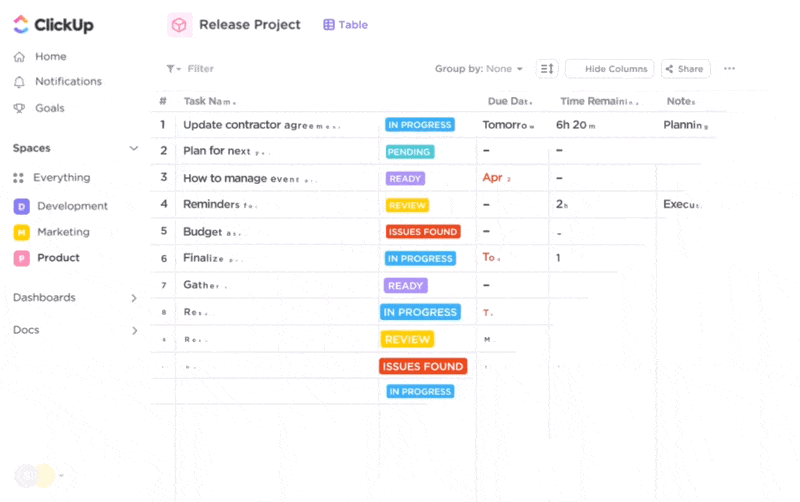هل شعرت من قبل بأنك تغرق في بحر من المهام والمسؤوليات في محاولة لمواكبة العمل والعائلة وكل ما ترميه الحياة في طريقك؟ هذا يحدث لأفضلنا. ولكن هناك طريقة للخروج من هذه المشكلة: نظام إنجاز المهام (GTD) . 🛟
يتمحور نظام GTD، الذي ابتكره خبير الإنتاجية ديفيد ألين، حول الحد من التوتر وعدم اليقين الذي يصاحب وابل المهام الذي لا ينتهي. فهو يقدم نهجًا منظمًا لإدارة المهام، مما يمكّنك من تحسين الإنتاجية وإدارة الوقت، وتبسيط سير عملك، وتحويل الأفكار المبعثرة إلى خطط قابلة للتنفيذ.
في هذا الدليل الشامل، سنشرح لك مبادئ GTD البسيطة والفعالة في نفس الوقت حتى تتمكن من التغلب على قائمة مهامك والتحكم في وقتك وحياتك. كما سنوضح لك أيضًا كيفية تنفيذ أساسيات GTD باستخدام انقر فوق وهي منصة رائدة في مجال الإنتاجية وإدارة المشاريع.
نظام GTD: الأصول
يمكن إرجاع أصول نظام GTD إلى أوائل الثمانينيات، عندما بدأ ديفيد ألين، وهو الآن مستشار إنتاجي بارز، في تعليم المؤسسات والأفراد كيفية تحسين الكفاءة وتقليل الضغط.
وجد ألين أن العديد من الأفراد لم يتمكنوا من التأقلم مع بيئة العمل الحديثة التي تتسم بالانقطاعات المستمرة وأعباء العمل المتزايدة والأولويات المتغيرة. ولاحظ أن التعقيد المتزايد وحجم المعلومات المتزايد في حياة الناس الشخصية والمهنية يؤثر سلباً على صحتهم البدنية والعقلية. ومن أبرز الآثار التي لاحظها ألين ما يلي:
- الإجهاد والإرهاق: وجد الأفراد صعوبة متزايدة فيتتبع المهاموالالتزامات والأفكار، مما يؤدي إلى الشعور بالقلق وانخفاض الإنتاجية
- مشاكل في تحديد الأولويات: جعلت المطالب المتنافسة والأولويات المتغيرة من الصعب على الأفراد تحديد ما يجب التركيز عليه بعد ذلك
- عدم الوضوح: غالبًا ما تسببت تقنيات وأدوات التنظيم وإدارة الوقت التقليدية مثل قوائم المهام المتعددة والملاحظات اللاصقة في حدوث ارتباك وعدم كفاءة
ولحل مشكلة إدارة الحياة المزدحمة في عالم يزداد تعقيدًا، طوّر ألين نهجًا رائدًا لإدارة العمل والحياة: نظام GTD. تم تقديم هذا النموذج لأول مرة في عام 2001، ويركز هذا النموذج على تسجيل جميع المهام والأفكار، وتنظيم المهام في فئات يمكن إدارتها، وتحديث قوائم المهام بانتظام، واتخاذ إجراءات قائمة على الأولويات.
تمكنك منهجية GTD، التي ترتكز على الانضباط الذاتي، من تخفيف العبء وتجنب الندم على عدم إنجاز المهام، مما يؤدي إلى زيادة الإنتاجية والإنجاز. دعنا نتعمق أكثر في مبادئها الأساسية.
قراءة إضافية: هل تعاني من الانضباط الذاتي؟ تحقق من بعض الأمثلة والنصائح التي يمكن أن تساعدك على بناء عادات أفضل .
ما هو نظام إنجاز المهام (GTD)؟
نظام إنجاز المهام (GTD) هو طريقة عملية لمعالجة المهام والمسؤوليات بكفاءة وسهولة. إنه نهج منظم لإدارة المهام يخفف من العبء الذهني لتتبع قوائم مهامك الشخصية والمهنية.
يعتمد نظام الإنتاجية هذا على مبدأ نقل المهام من العقل إلى نظام خارجي. وهذا يحرر الموارد الإدراكية، مما يسمح لك بالتركيز على المهمة التي بين يديك بدلاً من القلق بشأن ما هو قادم.
يتضمن سير عمل GTD خمس خطوات رئيسية. إليك لمحة موجزة عن كل منها:
- تبدأ بـ تجميع كل المهام والأفكار التي تتبادر إلى ذهنك. يمكن أن يكون هذا أي شيء من اجتماع عمل إلى قائمة البقالة. التقاطها خارجيًا، على سبيل المثال في أداة رقمية,برنامج إدارة المهامأو دفتر ملاحظات، يضمن عدم انزلاق أي شيء من خلال الشقوق 🗒️
- يمكنك توضيح المهام، وتقسيمها إلى خطوات قابلة للتنفيذ عند الضرورة. على سبيل المثال، إذا كنت مدير مشروع، فقد ترغب في تحديدما يجب القيام به للمضي قدمًا في كل ما يمكن إنجازه
- يمكنك تنظيم المهام عن طريق تعيين تسميات وعلامات أو تصنيفها إلى مشاريع. يساعدك هذا على إدارة عبء العمل وتحديد أولويات المهام بفعالية
- الانخراط في مهامك، مع التركيز على مهمة واحدة في كل مرة. لا يؤدي ذلك إلى تحسين إنتاجيتك فحسب، بل يضمن أيضًا جودة عملك
- أخيرًا، التأمل يتضمن مراجعة قائمة مهامك ومشاريعك بانتظام لضمان سير النظام بسلاسة. يتيح لك ذلك البقاء على اطلاع على التزاماتك، وإعادة تقييم أولوياتك، وإجراء التعديلات اللازمة
قراءة مقترحة: إنجاز المهام من تأليف ديفيد ألين
للحصول على فهم أعمق لنظام GTD، يمكنكم الاطلاع على كتاب ديفيد ألين الأساسي كتاب الإنتاجية ، إنجاز الأمور: فن الإنتاجية الخالية من الإجهاد، هو مورد لا غنى عنه. إنه الدليل النهائي حول طريقة GTD، وهو مليء بالرؤى والنصائح العملية من مبتكر الكتاب نفسه. وهو مصمم لمساعدتك في التغلب على تعقيدات الحياة العملية الحديثة، حيث يوفر استراتيجيات لإدارة مهامك والتزاماتك بكفاءة.

إنجاز الأمور: فن الإنتاجية الخالية من الإجهاد من تأليف ديفيد ألين
يتعمّق ألين في الجوانب النفسية للإنتاجية، ويشرح لماذا قوائم المهام التقليدية و تقنيات إدارة الوقت غالبًا ما تكون قاصرة. يركز منهجه على تحرير عقلك، مما يتيح لك البقاء على المهمة التي بين يديك وأن تكون أكثر إبداعًا. يتسم أسلوب الكتابة بالمحادثة والجاذبية، مما يجعل المفاهيم المعقدة في متناول اليد.
ومع ذلك، لا تنزعج من التعقيدات الأولية لنظام GTD. فالكتاب يقسم العملية إلى أجزاء يمكن التحكم فيها، ويرشدك خلال كل خطوة بنصائح عملية وتفسيرات واضحة. إنه مورد يمكنك العودة إليه مرارًا وتكرارًا لاكتشاف رؤى جديدة لمساعدتك الوصول إلى أهدافك الإنتاجية .
مكافأة: يمكن للأشخاص الفضوليين استكشاف بعض الكتب التي تركز على التركيز هنا .
## 5 خطوات من نظام GTD
في Getting Things Done، يشارك ديفيد ألين حكمة مارك توين: _سر المضي قدماً هو البدء. ويكمن سر البدء في تقسيم مهامك المعقدة المرهقة إلى مهام صغيرة يمكن إدارتها، ثم البدء في المهمة الأولى
ترتكز هذه الفلسفة على جوهر نظام GTD وخطواته الخمس الرئيسية. لنفحص كل واحدة منها عن كثب.

عبر Scoutups.com
الخطوة 1: الالتقاط
عندما يتبادر إلى ذهنك شيء ما - سواء كان مهمة عمل، أو حدثًا، أو فكرة، أو توصية بكتاب - فإن الخطوة الأولى من نظام GTD ترشدك إلى التقاطه. وهذا يعني تخزين المعلومات على الفور في نظام خارجي، والذي يسميه ألين صندوق الوارد. 📥
يمكن أن يكون صندوق الوارد أي مستودع مادي أو رقمي للمدخلات، طالما أنك لا تحتفظ بالمعلومات في دماغك (على حد تعبير ألين، رأسك مكتب سيء)، وهذا يضمن توثيق كل شيء بدقة ولا يضيع أي شيء في خلط الأوراق، ولا تضيع الأفكار أبدًا.
وكما يقول ديفيد آلن - عقلك هو لامتلاك الأفكار وليس الاحتفاظ بها، لذا، قم بتدوين كل ما يدور في ذهنك، من المهام إلى الأفكار، في نظام موثوق به، سواء كان قلم وورقة تقليدية أو تطبيق GTD الرقمي . ولا تقلق إذا كانت ملاحظاتك غير منظمة وفوضوية - سوف تقوم بترتيبها في الخطوة التالية.
يوصي ألين بالبدء في التقاط الأفكار من خلال القيام بما يسميه مسح الذهن للحلقات المفتوحة ويعني البحث بنشاط عن الأفكار التي تدور في ذهنك والتي قد تتطلب اتخاذ إجراء في مرحلة ما في المستقبل، حتى لو لم تكن تفكر فيها بنشاط.
الهدف من التقاط الأفكار؟ تحرير مساحة ذهنية للعمل المركّز من خلال توثيق كل ما يلفت انتباهك عند ظهوره. وفقًا لألن: _السر العظيم في الأهداف والرؤى لا يكمن في المستقبل الذي تصفه بل في التغيير في الحاضر الذي تولده
الخطوة 2: التوضيح
بمجرد أن تقوم بتدوين كل شيء، فإن الخطوة التالية في الـ GTD هي توضيحها. وهذا يعني مراجعة كل عنصر في صندوق الوارد الذي قمت بإنشائه في الخطوة السابقة وإعطائه بعض المعنى والهيكل.
والأهم من ذلك، عليك أن تقرر ما إذا كانت العناصر قابلة للتنفيذ.
إذا كان العنصر قابلاً للتنفيذ، يمكنك التفكير فيه كمهمة وتحديد الخطوة التالية للمضي قدمًا - إليك الطريقة:
- تستغرق المهمة أقل من دقيقتين لإكمالها: قم بها على الفور
- يمكن تفويض المهمة: إسنادها إلى شخص آخر
- يجب إنجاز المهمة، ولكن ليس على الفور: تحديد تاريخ الاستحقاق
- تتضمن المهمة أكثر من خطوة واحدة: قم بعمل مشروع لها
من ناحية أخرى، إذا لم يكن العنصر قابلاً للتنفيذ، يمكنك اختيار إهماله، أو احتضانه لاتخاذ إجراء مستقبلي محتمل، أو حفظه كمرجع. 🗑️
تساعدك عملية التوضيح هذه على فرز الفوضى وتحديد المهام المهمة حقًا والتخلص من المهام التي لا تستحق وقتك.
الخطوة 3: التنظيم
تتم عملية التنظيم عادةً بالتزامن مع عملية التوضيح، وهي تتمحور حول تمهيد الطريق للتنفيذ الفعلي للمهام التي تم التقاطها وتوضيحها في الخطوتين السابقتين. كلما قمت بتنظيم مهامك بشكل أفضل، كلما كان من الأسهل تنفيذ الخطوة التالية (التنفيذ).
ينصح ألين بتنظيم مهامك في فئات هرمية مختلفة مثل مجالات التركيز، والمشاريع، والقوائم القابلة للتنفيذ. يمكنك تصنيف مهامك وفقًا لمختلف التسميات والعلامات التي تنسبها إليها. يمكنك تجميع المهام بناءً على تاريخ استحقاقها أو مدى إلحاحها أو أولويتها أو حتى مقدار الوقت الذي تتطلبه كل مهمة. الأمر كله يتعلق بإنشاء نظام يناسبك.
الاتساق أمر بالغ الأهمية في هذه الخطوة. التزم بطريقة التنظيم التي اخترتها، وستجد أن المهام تبدو أكثر قابلية للإدارة. ستبدأ في رؤية التقدم والشعور بالإنجاز.
تذكّر كلمات ألين يمكنك القيام بأي شيء، ولكن ليس كل شيء.
الخطوة 4: الانخراط
الانخراط هو كل شيء يتعلق بالقيام بالعمل. لقد قمت بالفعل بوضع أساس متين، لذا فقد حان الوقت للثقة في النظام واتخاذ الإجراءات اللازمة. كان بيت القصيد من الخطوات السابقة هو تقديم إجابة على السؤال باستمرار: _ماذا نفعل بعد ذلك؟
ضع في اعتبارك السياق والوقت المتاح لك ومستوى الطاقة و أولوية المهام . لا تغوص فقط في المهمة الأكثر جاذبية. كن استراتيجيًا واتبع نظامك ودعه يرشدك.
وكما قال ألين _عندما يتم اتخاذ عدد كافٍ من خطوات العمل الصحيحة، سيكون قد تم إنشاء وضع ما يطابق صورتك الأولية للنتيجة بشكل وثيق بما يكفي لتتمكن من اعتبارها منجزة
الخطوة 5: المراجعة
إن مرحلة المراجعة في نظام GTD هي دفاعك الاستراتيجي ضد الفوضى، مما يضمن عدم انزلاق أي شيء من خلال الشقوق. تتطلب منك هذه الخطوة أن تعيد النظر بانتظام في قائمة مهامك، وترتبها وتعيد ترتيبها حسب الضرورة، للحفاظ على تحديث نظامك. 🌸
إنها فرصتك للتأكد من أن كل شيء في المكان الصحيح وأنك تركز على الأشياء الصحيحة. 🌸 قد تجد أن بعض المهام لم تعد ذات صلة بينما أصبحت بعض المهام الأخرى فجأةً ملحة. هذا هو الوقت المناسب أيضًا لإعادة تقييم أهدافك، مواءمة مهامك مع أولوياتك.
يتضمن نظام GTD نوعين من المراجعات:
- المراجعات اليومية: وهي مراجعات سريعة تتم كل يوم، إما في البداية أو في النهاية. ألق نظرة على التقويم الخاص بك وقائمة الإجراءات التالية لمعرفة ما يجب القيام به في ذلك اليوم
- المراجعات الأسبوعية: هذا هو العمود الفقري لـ GTD وهو غير قابل للتفاوض. خصص ساعة أو ساعتين في نهاية كل أسبوع لتصفية ذهنك والتأكد من أنك قمت بتسجيل وتوضيح جميع المهام والأفكار الواردة. راجع مشاريعك، وخطط المشاريع النشطة، وقائمة الإجراءات التالية، وقائمة الانتظار، وقائمة "يومًا ما/ربما
يعتبر ديفيد ألين المراجعة الأسبوعية "عامل نجاح حاسم" لأن إعادة النظر في نظامك بانتظام يضمن لك ألا تكون مشغولاً فقط بل أن تركز على المهام الصحيحة.
## الاستخدام الشائع لنظام GTD
بعد فترة وجيزة من تقديم ألين لنظام GTD في عام 2001، أصبح هذا النظام أحد أكثر أساليب الإنتاجية شيوعًا والأكثر تداولًا، خاصة بين مجموعة متزايدة من المتخصصين في مجال التكنولوجيا والمعرفة في الولايات المتحدة.
تم عرض أفكار ألين ومناقشتها باستمرار في المجلات الرائدة في العقد الأول من القرن الحادي والعشرين وأوائل العقد الأول من القرن الحادي والعشرين. وفي مقالة عام 2005 ، أشار موقع Wired إلى نظام GTD على أنه العبادة الجديدة لعصر المعلومات، بينما مجلة تايم وصفته في عام 2007 بأنه كتاب المساعدة الذاتية في مجال الأعمال الذي كان يُعرف في عصره.
بالإضافة إلى ذلك، ذُكر نظام GTD كثيرًا في مدونات الإنترنت الشهيرة في ذلك الوقت، مثل Lifehacker ومجلة The Simple Dollar التي لم تعد موجودة الآن. كما تم الترويج لها أيضًا من قبل شخصيات عامة مثل مقدم البرامج الإذاعية هوارد ستيرن والمدون ومذيع البودكاست ميرلين مان. وفي الوقت نفسه، طبقت العديد من الشركات متعددة الجنسيات، مثل جنرال ميلز، ورؤساءها التنفيذيين مبادئها في عملياتها.
وعلى الرغم من أن نظام GTD لم يعد شائعًا كما كان عليه قبل عقدين من الزمن و قد قوبل حتى بالنقد إلا أن بساطته وتعدد استخداماته لا تزال تجعله أسلوبًا شائعًا لإدارة الوقت والمهام بين المهنيين والطلاب والآباء والأمهات المقيمين في المنزل على حد سواء.
نصيحة إضافية: ابدأ في تنفيذ خطوات نظام GTD باستخدام هذه قوالب سير العمل المجانية !
مثال على نظام إنجاز المهام
لنتخيل أنك مدير تسويق تشرف على حملة تسويقية طموحة. إليك كيف يمكنك تطبيق نظام GTD لتحسين إدارة الوقت والإنتاجية، وقهر مهامك، وإكمال المشروع بنجاح:
- التقاط المهام والأفكار والمسؤوليات المتعلقة بالحملة. قد تكون هذه أفكارًا رائعة لمنشورات على وسائل التواصل الاجتماعي، أو انطباعات من آخر اجتماع مع العميل، أو رسالة بريد إلكتروني مهمة. في جميع الأحوال، انقل هذه العناصر من رأسك إلى صندوق خارجي
- قم بتوضيح كل عنصر في صندوق الوارد من خلال تحديد ما إذا كان قابلاً للتنفيذ أم لا. إذا كانت الإجابة بنعم، حدد الخطوات التالية. على سبيل المثال، عادةً ما يستغرق الرد على رسالة بريد إلكتروني أقل من دقيقتين ويجب القيام به على الفور. في هذه الأثناء، قد تقرر جدولة أو تفويض مهام مثل "إنشاء صور مرئية لمنشورات وسائل التواصل الاجتماعي"، وهي مهام مهمة ولكن لا يجب إكمالها على الفور
- قم بتنظيم المهام في فئات مختلفة من السياقات. على سبيل المثال، "إنشاء مرئيات لمنشورات وسائل التواصل الاجتماعي" يمكن أن تندرج تحت "إنشاء المحتوى"، بينما "التنسيق مع فريق التصميم" يمكن أن تندرج تحت "التعاون مع الفريق" قد تكون هناك فئة خاصة من المهام هي ما يسمى بالمهام لمرة واحدة. فهي تستغرق أكثر من دقيقتين ولكنها لا تشكل مشروعًا كاملاً أو تتطلب خطوات متعددة، مثل الموافقة على صورة مرئية على وسائل التواصل الاجتماعي
- تنفيذ المهام التي قمت بتوضيحها وتنظيمها، باتباعخطة الإنتاجية التي قمت بتطويرها باستخدام طريقة GTD
- قم بمراجعة قائمة المهام الخاصة بك بشكل دوري لتعديل الأولويات والتأكد من أنك تسير في الاتجاه الصحيح
تحديات استخدام نظام إنجاز المهام ## تحديات استخدام نظام إنجاز المهام
على الرغم من أن نظام إنجاز المهام يمكن أن يعزز الإنتاجية المهنية والشخصية بشكل كبير، إلا أنه لا يخلو من التحديات التي قد تحتاج إلى تجاوزها. ومن أبرز هذه التحديات ما يلي:
- الإعداد الأولي: يتطلب إعداد نظام GTD وقتًا وجهدًا، بالإضافة إلى فترة من التكيف مع سير العمل والعادات الجديدة
- الاتساق: تطبيق النظام هو عملية لا تنتهي أبدًا وتتطلب الانضباط والتفاني، وهو ما قد لا يكون ممكنًا خلال فترات الانشغال أو حالات الطوارئ
- التعقيد: التعقيد: قد تشعر بالإرهاق بسبب حجم المهام التي تحتاج إلى تسجيلها ومعالجتها وتنظيمها
- الافتقار إلى المرونة: إن GTD هو إطار عمل محدد مسبقًا، لذلك قد يكون مقيدًا للغاية وقد لا يستوعب دائمًا التغييرات المفاجئة أو المهام غير المتوقعة
- تبديل السياق : يستدعي نظام GTD تجميع المهام وفقًا للسياق، مثل الموقع أو الأدوات المطلوبة. لذا، فإن التبديل المستمر بين أنواع مختلفة من المهام والأدوات اللازمة لإدارتها يمكن أن يشتت الانتباه ويقلل من الإنتاجية
لحسن الحظ، هناك طرق أخرى للإنتاجية وإدارة المهام يمكنك استخدامها إما كبدائل أو كأدوات مكملة لنظام GTD. ومن أبرزها ما يلي:
- مصفوفة أيزنهاور : على عكس نظام GTD، تصنف هذه الطريقة بطبيعتها المهام بناءً على مدى إلحاحها وأهميتها. إنها أداة مرئية تقسم المهام إلى أربعة أرباع
- تقنية بومودورو : تنطوي على تقسيم العمل إلى فترات زمنية تسمى بومودورو، تستمر عادةً 25 دقيقة وتفصل بينها فترات راحة قصيرة
- كانبان : يتيح لك تصور المهام كبطاقات على لوحة، حيث تمثل الأعمدة المختلفة مراحل المهام المختلفة، مثل تنجز و تجري و تجري و تركت. ما عليك سوى نقل البطاقات إلى أعمدة مختلفة لتغيير حالات المهام
ماذا لو قلنا لك أنه لا يزال بإمكانك استخدام نظام GTD دون الاكتفاء بمحدوديته أو اللجوء إلى البدائل؟ أخبار جيدة! لا يوجد أي تنازلات مع ClickUp، منصة الإنتاجية الشاملة التي تتيح لك استخدام أي طريقة تريدها لإدارة مهامك ووقتك كالمحترفين!
كيفية تطبيق نظام GTD باستخدام ClickUp
مع أكثر من 1,000 قالب جاهز والعديد من أدوات التعاون وإدارة الوقت، و أكثر من 15 طريقة عرض قابلة للتخصيص للبقاء على اطلاع على مهامك ومشاريعك، يزودك ClickUp بكل ما تحتاجه لإطلاق العنان لإنتاجية غير مسبوقة. 💪
إذا كنت جديدًا على نظام GTD وتحتاج إلى اختصار لإعداد كل شيء، ستحب ClickUp قوالب GTD . فهي توفر إطار عمل مُعد مسبقًا لالتقاط مهامك ومعالجتها واستكمالها. إليك أفضل اختياراتنا:
- قالب ClickUp لإنجاز المهام
- قالب نموذج إطار عمل ClickUp لإنجاز المهام
- قالب القائمة البسيطة لإنجاز المهام في إطار عمل ClickUp Getting Things Done

يساعدك قالب إنجاز المهام (GTD) على تنظيم كل تلك الأفكار في موقع مركزي واحد
دعنا نرى كيف يمكنك استخدام ClickUp لتنفيذ كل خطوة من الخطوات الخمس لنظام GTD بفعالية: 👇
الخطوة 1: سجل كل شيء
لا تشدد على تنظيم أو تفصيل كل شيء؛ فالخطوة الأولى هي إخراج أفكارك من رأسك إلى موقع مركزي يسهل الوصول إليه.
يتيح لك ClickUp التقاط الأفكار والخواطر دون عناء من خلال ميزة المفكرة . إنها مثالية لتدوين التذكيرات السريعة, ملاحظات الاجتماع أو أي شيء آخر يخطر ببالك. ما عليك سوى النقر على أيقونة المفكرة في أسفل يمين الشاشة، وستكون جاهزًا للعمل. كل ملاحظة لها عنوانها وتاريخها، ويمكنك حتى توسيعها أو الإضافة إليها لاحقًا.

سجِّل الملاحظات والأفكار والتذكيرات السريعة باستخدام ClickUp Notepad
إذا كنت ترغب في الانتقال بتدوين ملاحظاتك إلى المستوى التالي، فاستخدم مستندات ClickUp . هو محرر النصوص ونظام إدارة المستندات الخاص بالمنصة الذي يتيح لك إنشاء المستندات وتحريرها والتعاون في الوقت الفعلي.
من خلال إضافة روابط وصور وإشارات مرجعية وجداول إلى المستندات، يمكنك إضافة المزيد من العمق والسياق إلى أفكارك لالتقاط تلك الحلقات المفتوحة التي ذكرناها سابقًا بشكل أفضل. يمكنك أيضًا إنشاء صفحات فرعية متداخلة، وربط المستندات ببعضها البعض، وإنشاء فئات لسهولة الوصول إليها والبحث فيها.

احصل على عرض سريع لجميع صفحاتك الفرعية المتصلة وعلاقاتك على مستندات ClickUp Docs لتظل منظمًا وتحافظ على اتصال العمل
الخطوة 2: توضيح الأشياء لأعلى
مع التقاط أفكارك وأفكارك وصورك وروابطك وتخزينها بدقة في المفكرة والمستندات الخاصة بك، حان الوقت لتقرر ما يجب فعله بشأنها. إذا قررت أن عنصرًا معينًا قابل للتنفيذ, إنشاء مهمة لها باستخدام مهام النقر فوق المهام ، مجموعة إدارة المهام الخاصة بالمنصة.
ضمن كل مهمة من مهام ClickUp، يمكنك وصف ما يجب القيام به، وتقسيم المهمة إلى مهام فرعية أصغر , تعيين التعليقات لنفسك أو لفريقك للحصول على معلومات إضافية، أو إضافة تذكيرات.

تأكد من رؤية تعليقاتك من خلال تعيين تعليقات للمستخدمين مباشرةً في المهام، واحصل على عرض سريع للتعليقات المعينة في قائمة التحقق
تتيح لك هذه الميزة توضيح كل مهمة بأدق التفاصيل عن طريق إضافة صور أو روابط أو مستندات كاملة كمواد مرجعية. يمكنك أيضًا إرفاق قوائم التحقق وقوائم المهام و تعيين تواريخ الاستحقاق للمهام الأكثر تعقيدًا التي لن تنتهي منها على الفور.

قم بتعيين تواريخ البدء والاستحقاق بسهولة وسرعة داخل المهمة أو استخدم الإعدادات الشرطية لتكرار التواريخ أو إنشاء مهمة جديدة بعد الانتهاء
يتيح لك ClickUp أيضًا إضافة مستويات الأولوية إلى المهام الخاصة بك لتحديد ترتيب التنفيذ بسرعة، وهو عنصر أساسي في نظام GTD. هناك أربعة مستويات: عاجل، عالي، عالي، عادي، منخفض، وكل مستوى منها يحمل علامة أولوية مرمزة بالألوان لسهولة التعرف عليها.

حدد الأولويات في ClickUp للتمييز بشكل أفضل بين ما يجب القيام به الآن وما يمكن تأجيله
الخطوة 3: قم بالتنظيم
الآن بعد أن أضفت أكبر قدر ممكن من التفاصيل إلى مهامك، حان الوقت لتنظيمها وتجميعها بناءً على المعايير المحددة مسبقًا، مثل التعقيد والسياق ومستوى الجهد والأولوية وغير ذلك.
إذا كنت بحاجة إلى معايير إضافية لتصفية المهام وفرزها، يمكنك تصنيفها باستخدام علامات المهام أو إنشاء الحقول المخصصة لإضافة مستوى إضافي من التنظيم. من خلال إنشاء العلاقات والتبعيات يمكنك الانتقال بسرعة بين المهام ذات الصلة وإنشاء ترتيب واضح للتنفيذ.

قم بتحسين تنظيم مهامك عن طريق إضافة علامات مخصصة واستخدام خيارات التصفية في طريقة عرض القائمة واللوحة لتحديد مهامك ذات الأولوية القصوى بدقة
مع ميزة التسلسل الهرمي في ClickUp ، يمكنك تبني طريقة GTD بشكل كامل من خلال تنظيم مهامك من أجل التنقيح والعمل. تتيح لك هذه الميزة ترتيب المهام ذات السمات المشتركة في قوائم، بينما يمكن أن تشكل عدة قوائم مترابطة مجلداً. يمكنك تجميع عدة مجلدات في مساحة، وهي الوحدة التنظيمية الأوسع داخل مساحة عمل ClickUp.

حافظ على تنظيم المهام وحدد موقعها بشكل أسرع باستخدام ميزات التسلسل الهرمي للمشروع في ClickUp
يحتوي ClickUp على ميزة فريدة أخرى لتجميع وتتبع المهام ذات الصلة- أهداف ClickUp . استخدمه لتعيين أهداف قابلة للقياس ومحددة زمنياً لإكمال مشاريعك وأهدافك طويلة الأجل ومراقبة تقدمك نحوها من خلال التتبع التلقائي للتقدم المحرز. يمكنك أيضًا إنشاء مجلدات منفصلة للأهداف الشخصية والفريقية المهمة.

حافظ على أهدافك و OKRs منظمة داخل مجلدات سهلة الاستخدام في ClickUp Goals
الخطوة 4: الانخراط والغوص في العمل
خطوة الانخراط هي الخطوة التي تشمّر فيها عن سواعدك وتتعامل مع مهامك مباشرةً. مع صفاء ذهنك وتنظيم كل شيء، كل ما عليك فعله هو إنجاز المهام.
يمكن أن يساعدك ClickUp في هذه الخطوة من نظام GTD من خلال التعاون في الوقت الفعلي و ميزات إدارة الوقت التي تبسط سير العمل وتعزز الإنتاجية. إليك المزايا المفضلة لدينا:
- اللوحات البيضاء : تعتبر هذه اللوحات اللانهائية ممتازة للعصف الذهني التعاوني وطرح الأفكار. يمكنك الانتقال من الأفكار إلى العمل في ثوانٍ عن طريق تحويل العناصر الموجودة على السبورات البيضاء إلى مهام
- الخرائط الذهنية : استخدمها لرسم الروابط بين الأفكار والمهام لتسهيل التخطيط والتنفيذ
- تتبع وقت المشروع : سجل الوقت الذي تقضيه في المهام، وقم بتعيين تقديرات الوقت وإضافة ملاحظات من أي جهاز
- عرض الدردشة : تتيح لك أداة الاتصال الأصلية في ClickUp مشاركة التحديثات والتعاون بسلاسة مع فريقك في الوقت الفعلي
الخطوة 5: مراجعة العملية
يعد التحقق من التقدم والحالة أمرًا بالغ الأهمية في جعل نظام GTD الخاص بك يعمل. تضمن لك مراجعة قائمة مهامك وتحديثها بانتظام أنك تتحرك في الاتجاه الصحيح. فهو يتيح لك الاستجابة للتغييرات المفاجئة، وتحديد مجالات التحسين، والتفكير في عملك.
تتيح لك طرق العرض القابلة للتخصيص في ClickUp تصور ومراقبة مهامك ومشاريعك من كل زاوية ممكنة حتى تتمكن من مراقبة تقدمك. ستجد طرق العرض التالية مفيدة في سياق نظام GTD:
- عرض اللوحة : لوحة على غرار كانبان تمنحك نظرة عامة شاملة لجميع مهامك وحالاتها
- عرض عبء العمل : يوضح حجم العمل لكل عضو من أعضاء الفريق خلال فترة محددة
- عرض جانت : يصور ويخطط لتقدم المشروع ويدير الموارد ويحدد المعالم والعوائق
- عرض الجدول الزمني : يسمح بجدولة المهام وتصور المهام في عرض خطي
- عرض التقويم : يتيح لك إدارة الجداول الزمنية وجدولة المهام ومراجعة تفاصيل العمل بسرعة

توفر طرق عرض ClickUp التي يزيد عددها عن 15 طريقة عرض للمؤسسات حلاً شاملاً لكل فريق
ClickUp: الحل النهائي لإتقان GTD
على الرغم من أن طريقة GTD تتفوق في التخلص من الفوضى في ذهنك وتنظيم المهام، إلا أنها لا تضيف ساعات إلى يومك بطريقة سحرية. إذا كنت مثقلاً بالمهام، فإن إدارة وقتك بفعالية أمر لا بد منه.
وكما يؤكد ديفيد ألين، الآن هي اللحظة المناسبة لـ _تحكم في ما نستطيع، مع الأشخاص المناسبين، وفي الوقت المناسب
وبفضل ميزات وقوالب ClickUp متعددة الاستخدامات، أصبح تطبيق نظام GTD أكثر سهولة من أي وقت مضى. اشترك اليوم مجاناً للتحكم في وقتك و إنجاز المهام بسهولة! 👏

